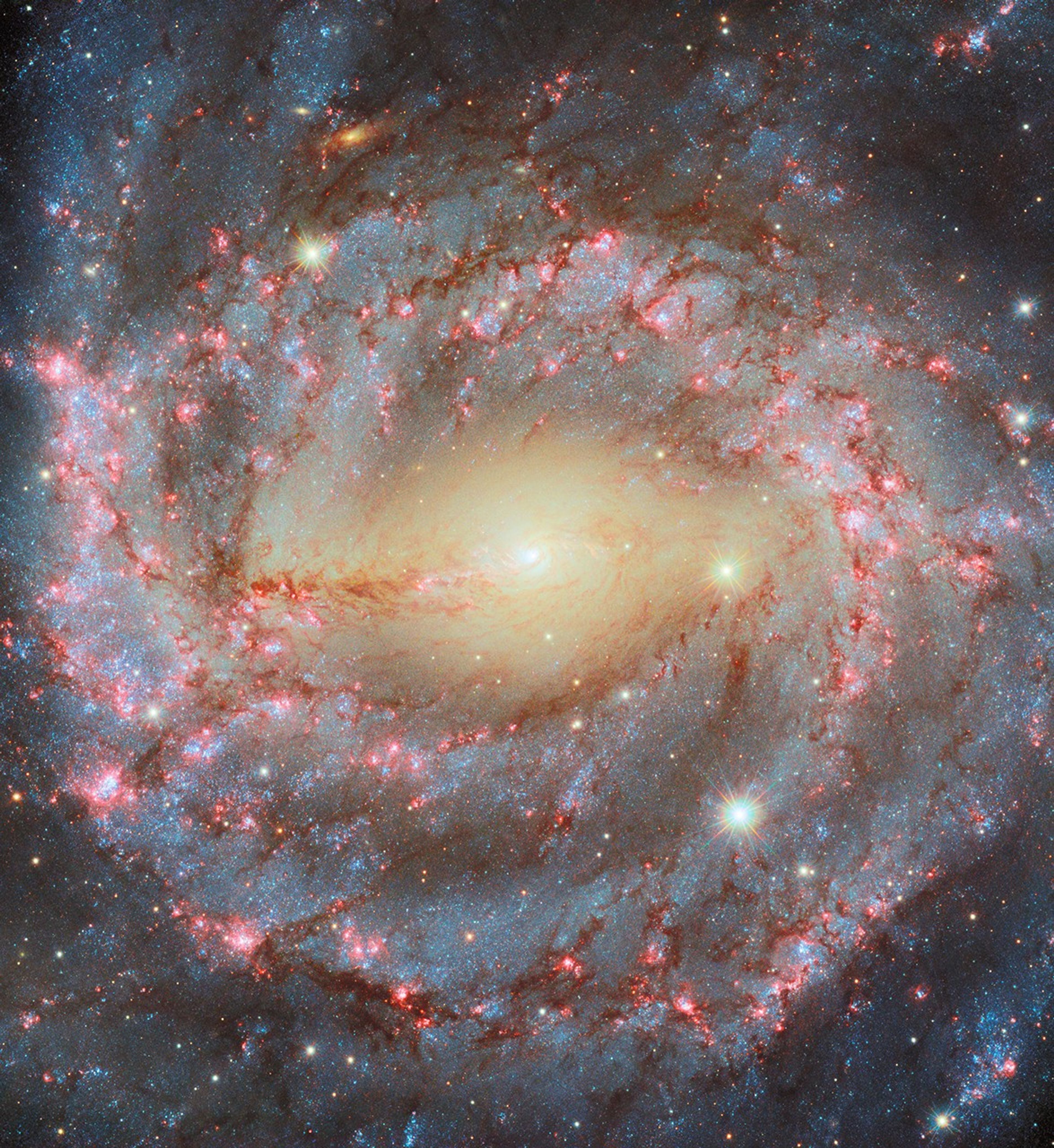The Marshall Star
The Marshall Star for October 4, 2023.
Agency Leadership Talks NASA 2040, Artemis, Budget at Marshall Town Hall
By Jessica Barnett
From funding to historic achievements to the future of NASA, there was no shortage of topics for discussion during the latest Marshall Town Hall.
Marshall team members joined in person and online as Acting Marshall Center Director Joseph Pelfrey, NASA Administrator Bill Nelson, Deputy Administrator Pam Melroy, Associate Administrator Bob Cabana, and Deputy Associate Administrator Casey Swails shared their goals for Marshall and the agency’s future and answered questions from the audience in Activities Building 4316 on Sept. 18.
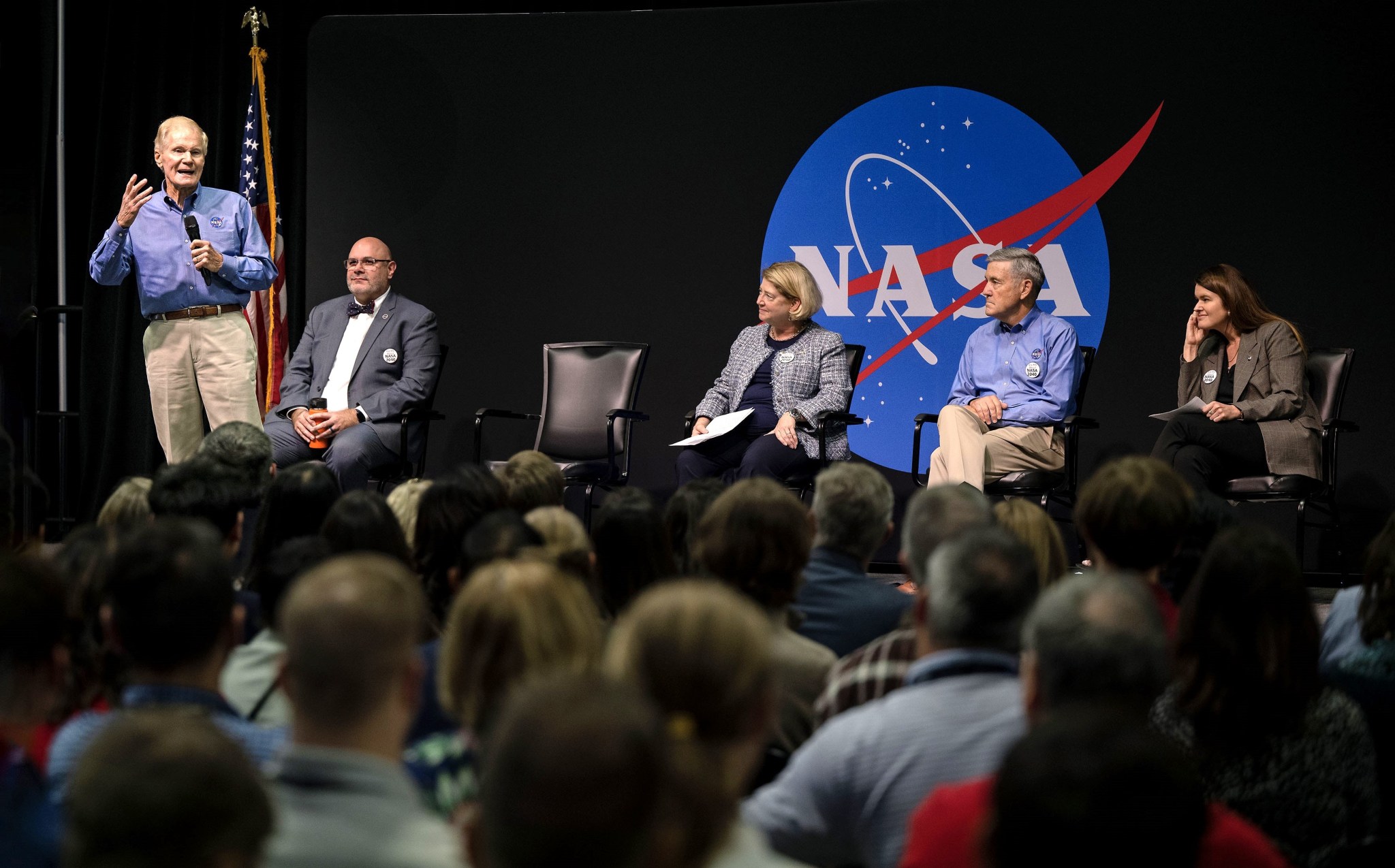
Pelfrey kicked off the town hall by welcoming agency leaders and showering praise on the Marshall team.
“It’s exciting to see the accomplishments of what we’re doing as an agency and see so many parts of that have a Marshall fingerprint,” Pelfrey said. “It’s an honor to have our leadership team here to share some of the things going on within our agency and how Marshall fits into those plans.”
Nelson followed Pelfrey’s speech with another round of praise, calling Marshall team members “wizards who make the impossible possible.”
“We’re going back to the Moon to learn, to live, to create, to invent, in order for us to go to Mars and beyond, to discover those far, distant cosmic shores,” Nelson said. “And Marshall is very much a part of this.”
That work is being supported in part by NASA 2040, a strategic agency initiative aimed at driving meaningful changes that will allow the agency to realize its long-term vision for what leaders want the agency to be in 2040.
“Personally, I think it’s NASA’s role to do really hard things that only NASA can do,” Swails said. “When we talk about 2040 and we talk about our mission strategy, how we do make sure we have an operating model that best sets us up for a future that aligns to mission goals? How do we make sure we have an institution that frankly reflects how amazing and incredible our mission is?”
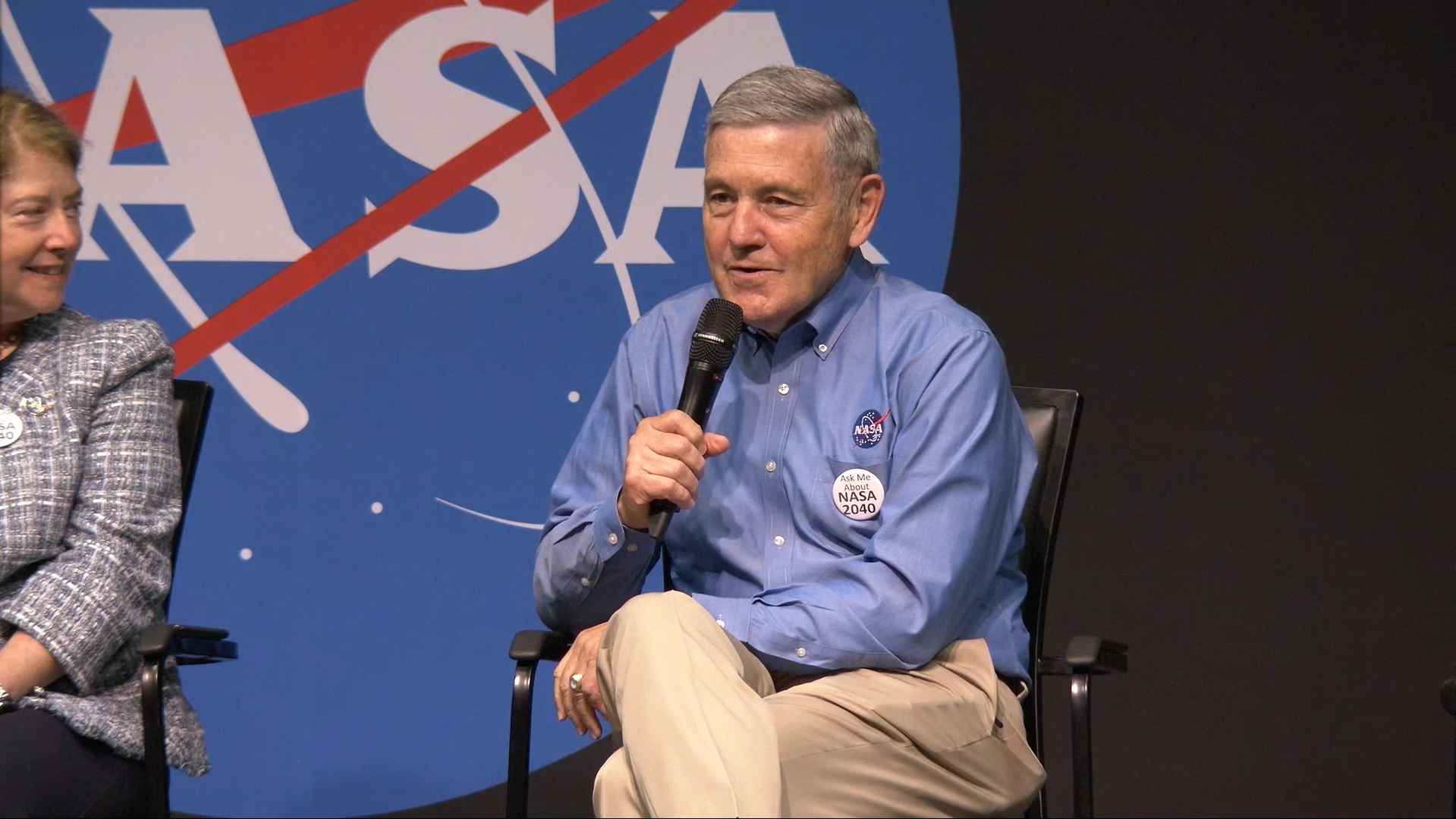
Swails then presented the plan to achieving those goals which included a seven-part list of workstreams with associated teams and leaders focused on supporting the workforce, infrastructure, and technologies critical to keeping NASA a leader in science, aeronautics, and space exploration.
In addition to her speech, Swails held meetings Sept. 22 to further discuss NASA 2040. Cabana stressed the importance of such meetings and listening sessions during his portion of the town hall, encouraging Marshall team members to seize the opportunity to attend and offer feedback.
Agency leaders also shared how Marshall is key to not just the initiative’s success but the success of NASA’s mission.
“It’s important that we articulate and emphasize the science, technology, and impact we have,” Melroy said. “I’m personally excited, as I see the incredible science you work on here with ISS, what new discoveries we’re going to get with Artemis.”
Melroy and Cabana noted Marshall’s work on nuclear propulsion, with Artemis, and with the International Space Station.
“You’re not making a difference for Marshall Space Flight Center, the state of Alabama, or even the United States,” Cabana said. “You’re making a difference for humanity.”
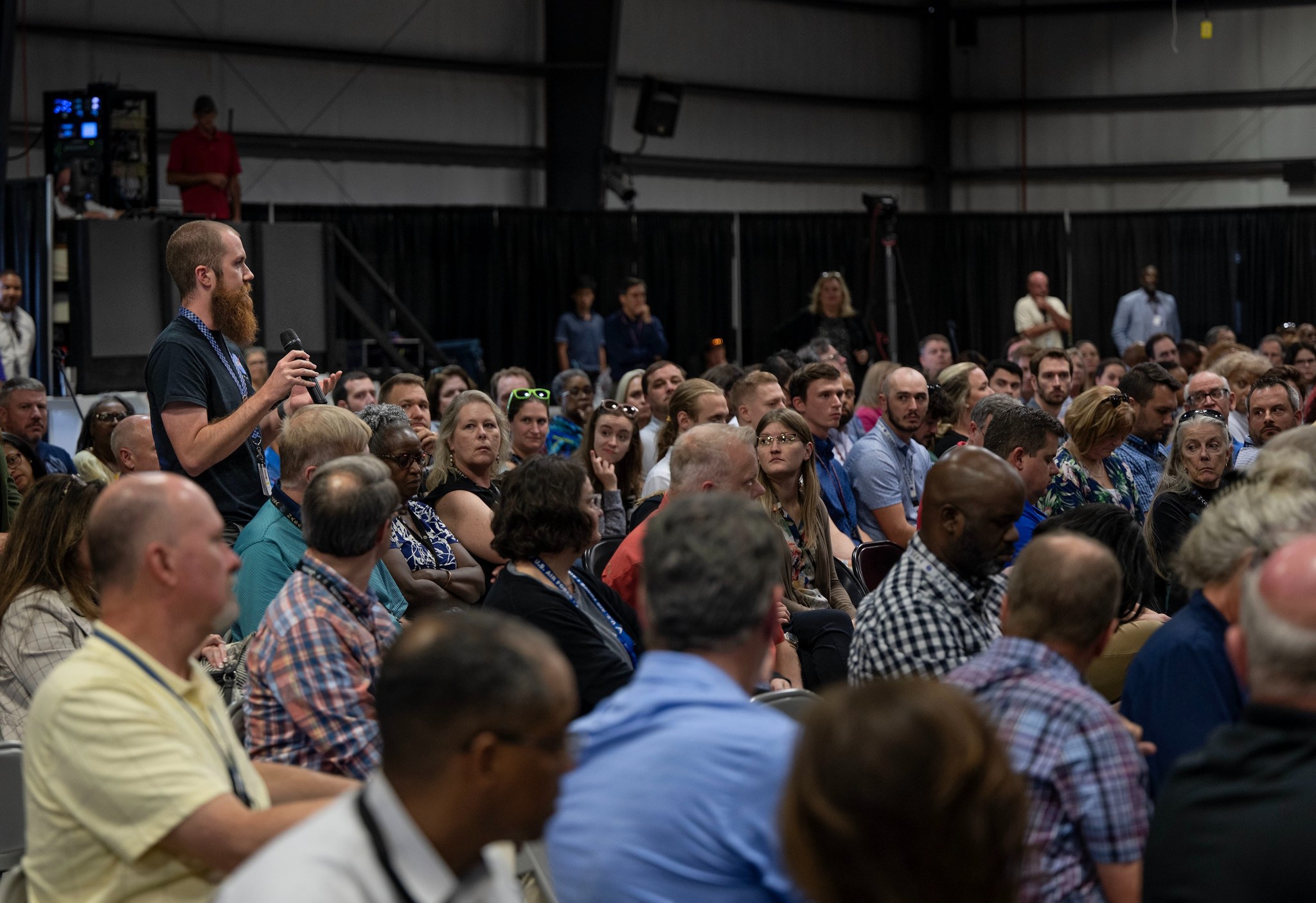
Cabana provided an update on the Artemis program, telling audience members that Artemis II is still on track for its launch next year and work is underway to prepare for Artemis III’s launch in 2025. He encouraged Marshall team members to be active participants and promote an inclusive environment as the agency continues toward 2040.
“What we are doing is too critical not to give it our very best and have that environment,” he said.
Also critical, however, is ensuring NASA has the budget for its goals. Nelson, a former U.S. senator, said he isn’t sure what those currently in Congress will decide, but he remains confident that NASA will be just fine.
He said there’s talk of NASA receiving level funding, which has caused angst among some, but that NASA’s international reach has made it favorable on both sides of the political aisle.
“At the end of the day, it’s going to be all right,” Nelson said. “There will be some bumps along the way on this budget; it is a sign of the times. I wish it were not that way, but I can tell you that NASA brings people together, and NASA unites, not just in domestic politics but around the world as well.”
Barnett, a Media Fusion employee, supports the Marshall Office of Communications.
Marshall Wins Award for Most Funds Raised During 2022 Combined Federal Campaign
By Jessica Barnett
NASA’s Marshall Space Flight Center was recently awarded for raising more funds than any other large federal agency in the Greater Tennessee Valley Zone during the 2022 CFC (Combined Federal Campaign).
The CFC serves as the federal government’s only sanctioned charity fundraiser event, with civilian, military, contract, and postal employees all encouraged to contribute to the charity of their choice during the annual campaign.
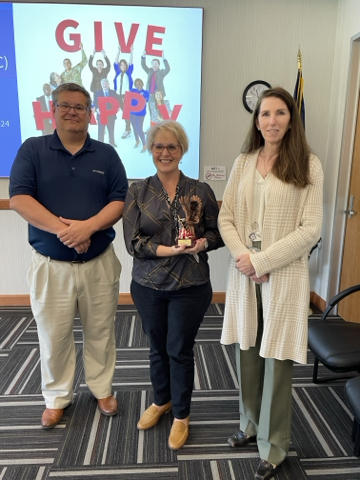
Marshall kicked off the 2022 campaign last October with a charity fair, giving potential donors a chance to learn about some of the charities that benefit from CFC donations. Erin Richardson, a materials science manager at Marshall who served as chair of the 2022 campaign, said the goal was more than just raising funds – it was about raising awareness of CFC and increasing participation in the campaign.
“We ended up contributing the most out of any large agency in the Greater Tennessee Valley, which is our CFC zone,” Richardson said, adding the win came as a surprise given some of the obstacles they faced.
Those obstacles included inflation and economic concerns among potential donors, balancing virtual and in-person campaigning after the pandemic, and it being the first time Richardson and many of her co-campaigners had served as CFC leaders at Marshall.
Looking back on it now, she said, there were certainly some lessons learned. Richardson said she’s optimistic for the 2023 campaign, which will be chaired by Angela Lovelady, a lead budget analyst at Marshall.
“Angela is a step above,” Richardson said. “She has an intense passion and heart for it, and I think she’ll be a great lead for CFC.”
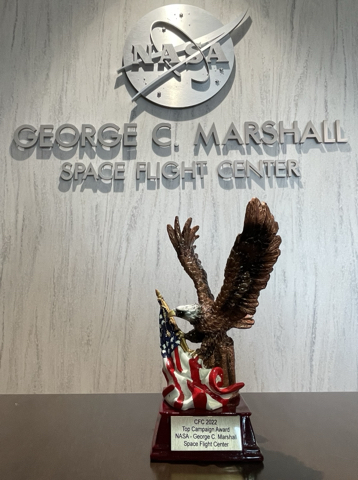
Marshall team members who wish to match that enthusiasm will have plenty of ways to do so when the 2023 campaign kicks off Oct. 17. Donors can contribute financially via credit or debit card payment or PayPal, with some team members able to donate a portion of their paycheck during the campaign period. Donors can also contribute their time at a participating charity, with each volunteer hour counted toward the overall fundraising goal.
All campaigns start after Sept. 1 and end before mid-January of the following year. Each donation must be designated for a specific participating charity. In the Greater Tennessee Valley Zone, there are 69 charities currently listed as active CFC participants, from community health clinics and animal rescues to veteran and social justice groups.
By participating in CFC each year, Marshall can show its support to the people all over the world, including the millions of U.S. taxpayers who make NASA’s mission possible, Richardson said.
“We benefit so much as federal employees from taxpayers,” she said. “Some people will never get the opportunity to come through Gate 9 or see a launch or understand what we do, but we wouldn’t be able to do the job we are doing without them.”
Learn more about CFC and see the list of participating charities in your community by visiting https://cfcgiving.opm.gov.
Barnett, a Media Fusion employee, supports the Marshall Office of Communications.
Ceremony Marks Opening of NASA Educational Display at New Orleans Airport
Representatives from NASA’s Michoud Assembly Facility joined elected officials and other community leaders for a ribbon-cutting ceremony marking the opening of a NASA educational display Sept. 26 at Louis Armstrong International Airport in New Orleans.
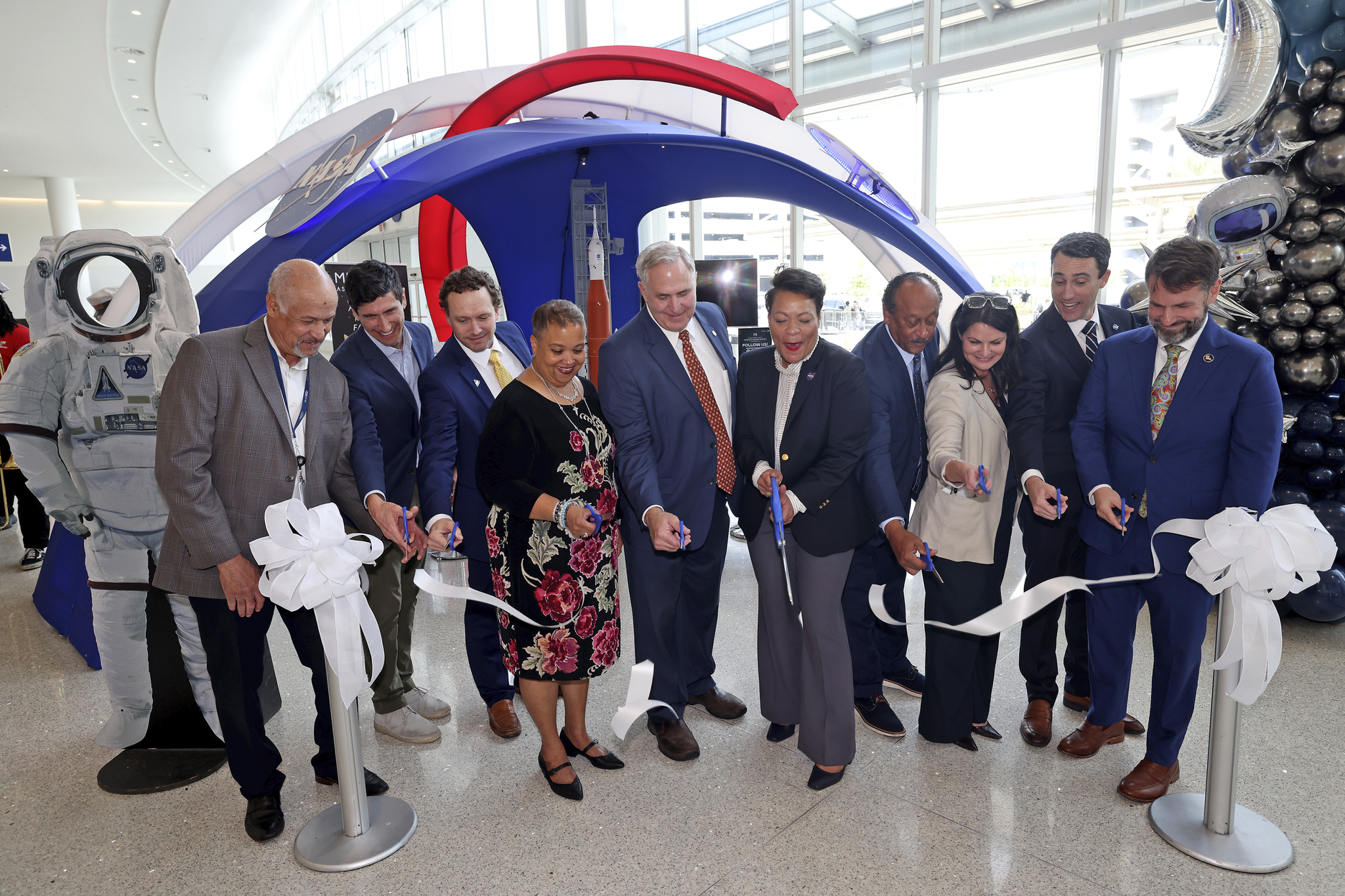
The exhibit is a collaboration between NASA, the city of New Orleans, and regional economic development organizations to educate visitors on the role Michoud has played in the production of manned spacecraft and Michoud’s impact on economic development for the region. The exhibit is located near the airport’s baggage claim on the first floor.
Michoud serves as America’s “rocket factory,” manufacturing and assembling NASA’s SLS (Space Launch System) core stages and Exploration Upper Stage, and the Orion crew module. Michoud is managed by NASA’s Marshall Space Flight Center.
Start Your Engines: NASA to Begin Critical Testing for Future Artemis Missions
NASA will begin a new RS-25 test series Oct. 5, the final round of certification testing ahead of production of an updated set of the engines for the SLS (Space Launch System) rocket. The engines will help power future Artemis missions to the Moon and beyond.
A series of 12 tests stretching into 2024 is scheduled to occur on the Fred Haise Test Stand at NASA’s Stennis Space Center. The tests are a key step for lead SLS engines contractor Aerojet Rocketdyne, an L3Harris Technologies company, to produce engines that will help power the SLS rocket, beginning with Artemis V.
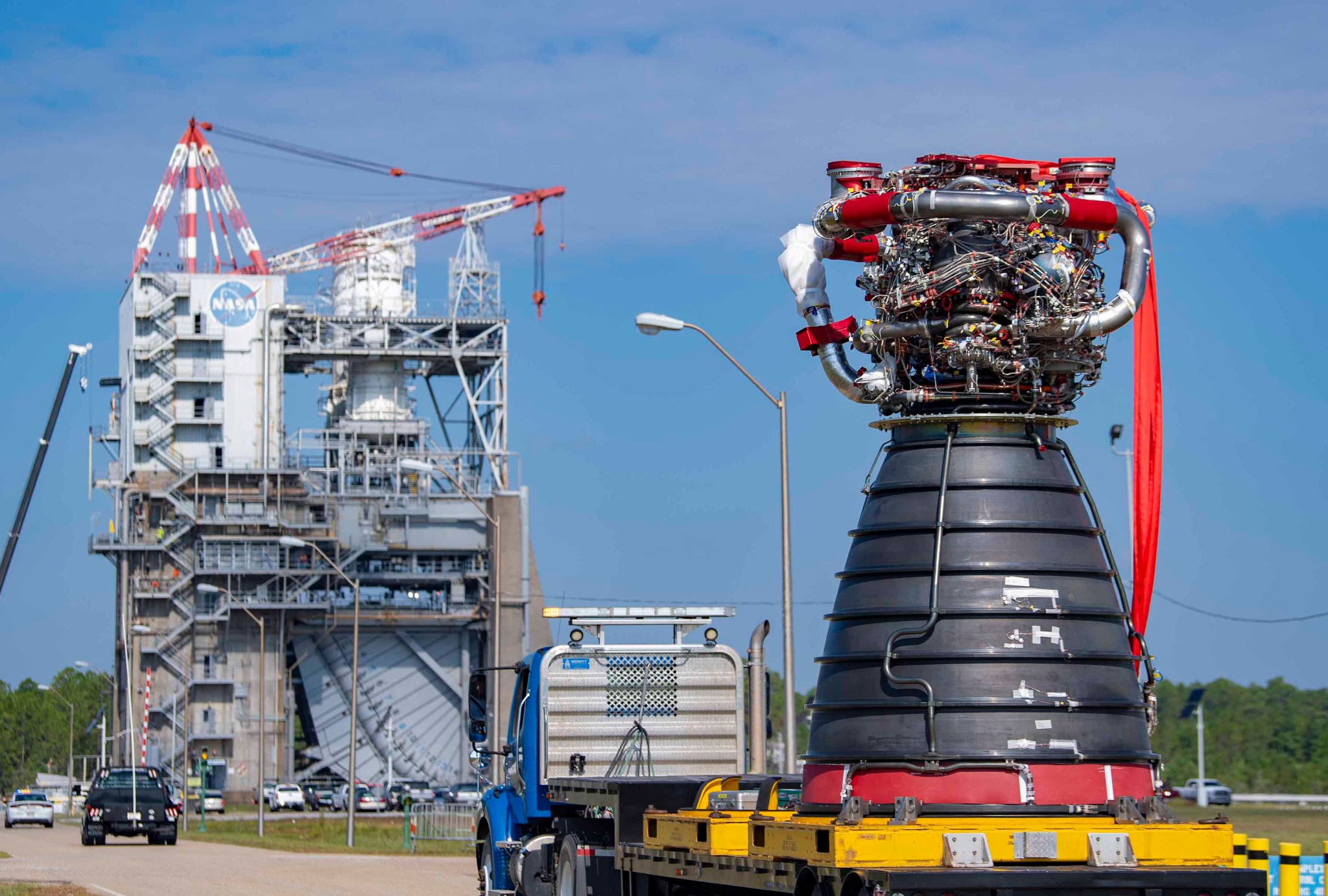
“NASA and our industry partners continue to make steady progress toward restarting production of the RS-25 engines for the first time since the space shuttle era as we prepare for our more ambitious missions to deep space under Artemis with the SLS rocket,” said Johnny Heflin, liquid engines manager for SLS at NASA’s Marshall Space Flight Center. “The upcoming fall test series builds off previous hot fire testing already conducted at NASA Stennis to help certify a new design that will make this storied spaceflight engine even more powerful.”
For each Artemis mission, four RS-25 engines, along with a pair of solid rocket boosters, power the SLS rocket, producing more than 8.8 million pounds of thrust at liftoff. Following a “test like you fly” approach, all 12 tests in the new series are scheduled for at least 500 seconds, the same amount of time the engines must fire during an actual launch.
The 12-test series will use developmental engine E0525 to collect data for the final RS-25 design certification review. The engine features a second set of new key components, including a nozzle, hydraulic actuators, flex ducts, and turbopumps. The components match design features of those used during the initial certification test series completed at the south Mississippi site in June.
“Testing a second set of hardware during this next phase of our certification test series will give us repeatability to ensure we have sound processes for building our new engines,” said Mike Lauer, RS-25 deputy program manager at Aerojet Rocketdyne. “The successful testing of the brand-new certification engine proved our engineering was sound – that the new design is capable of meeting requirements at operating extremes and durations. This next test series will help confirm our manufacturing processes will reliably create production engines that will meet these same requirements.”
Operators will fire the engine at power levels varying between 80% and 113% to test performance in multiple scenarios. The first four Artemis missions are using modified space shuttle main engines that can power up to 109% of their rated level. New RS-25 engines will power up to the 111% level to provide additional thrust. Testing up to the 113% power level provides a margin of operational safety.
The longest test of the new series is planned for 650 seconds. Crews will conduct a gimbal test of the engine to ensure it can pivot as needed to help SLS maintain stability and trajectory during flight. The Oct. 5 test is scheduled for 550 seconds and will fire the RS-25 engine up to 111% power level.
Overall, a total of 6,350 seconds of hot fire is planned for the series. With completion of the campaign, it is anticipated all systems will be “go” to produce 24 new RS-25 engines using the updated design for missions beginning with Artemis V.
“Testing at the historic Fred Haise Test Stand is critical to ensure that our astronauts fly safely,” said Chip Ellis, project manager for RS-25 testing at NASA Stennis. “The test team takes great care to ensure these engines will operate as designed to launch NASA payloads and astronauts to the Moon and beyond.”
Through Artemis, NASA will use innovative technologies and collaborate with commercial and international partners to explore more of the Moon than ever. The agency will use what is learned on and around the Moon to take the next giant leap of sending the first astronauts to Mars.
Marshall manages the SLS Program.
Chandra Rewinds Story of Great Eruption of the 1840s
A new movie made from over two decades of data from NASA’s Chandra X-ray Observatory shows a famous star system changing with time. Eta Carinae contains two massive stars (one is about 90 times the mass of the Sun and the other is believed to be about 30 times the Sun’s mass).
In the middle of the 19th century, skywatchers observed as Eta Carinae experienced a huge explosion that was dubbed the “Great Eruption.” During this event, Eta Carinae ejected between 10 and 45 times the mass of the Sun. This material became a dense pair of spherical clouds of gas, now called the Homunculus nebula, on opposite sides of the two stars. The Homunculus is clearly seen in a composite image of the Chandra data with optical light from the Hubble Space Telescope (blue, purple, and white).
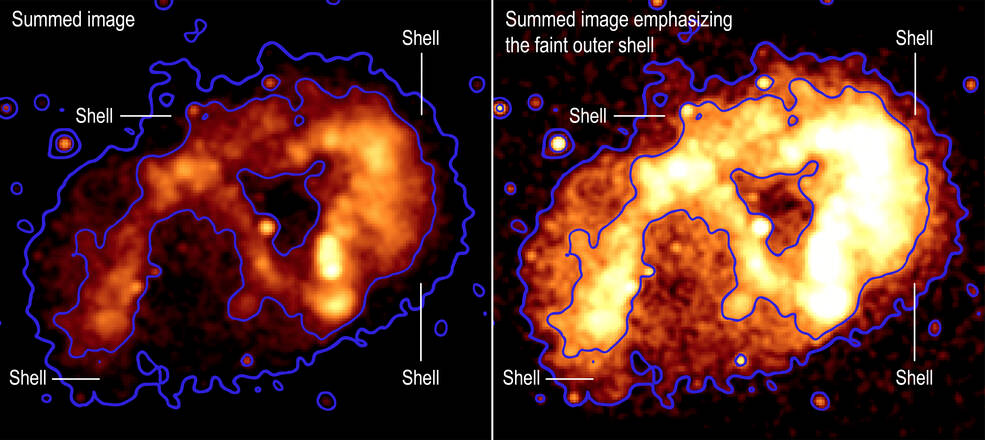
A new time-lapse sequence contains frames of Eta Carinae taken with Chandra from 1999, 2003, 2009, 2014, and 2020. Astronomers used the Chandra observations along with data from ESA’s XMM-Newton to watch as the stellar eruption from about 180 years ago continues to expand into space at speeds up to 4.5 million miles per hour. The two massive stars produce the blue, relatively high energy X-ray source in the center of the ring. They are too close to each other to be seen individually.
A bright ring of X-rays (orange) around the Homunculus nebula was discovered about 50 years ago and studied in previous Chandra work. The new movie of Chandra, plus a deep, summed image generated by adding the data together, reveal important hints about Eta Carinae’s volatile history. This includes the rapid expansion of the ring, and a previously unknown faint shell of X-rays outside it.
This faint X-ray shell is highlighted in an additional graphic showing the summed image. The image on the left emphasizes the bright X-ray ring, and the image on the right shows the same data but emphasizing the faintest X-rays. The shell is located in between the two contour levels, as labeled.
Because the newly discovered outer X-ray shell has a similar shape and orientation to the Homunculus nebula, researchers concluded both structures have a common origin. The idea is that material was blasted away from Eta Carinae well before the 1843 Great Eruption – sometime between 1200 and 1800, based on the motion of clumps of gas previously seen in Hubble Space Telescope data. Later this slower material was lit up in X-rays when the fast blast wave from the Great Eruption tore through space, colliding with and heating the material to millions of degrees to create the bright X-ray ring. The blast wave has now traveled beyond the bright ring.
A paper describing these results appeared in The Astrophysical Journal. The authors of the paper are Michael Corcoran (NASA’s Goddard Space Flight Center), Kenji Hamaguchi (GSFC), Nathan Smith (University of Arizona), Ian Stevens (University of Birmingham, UK), Anthony Moffat (University of Montreal), Noel Richardson (Embry-Riddle Aeronautical University), Gerd Weigelt (Max Planck Institute for Radio Astronomy), David Espinoza-Galeas (The Catholic University of America), Augusto Damineli (University of Sao Paolo, Brazil), and Christopher Russell (Catholic University).
NASA’s Marshall Space Flight Center manages the Chandra program. The Smithsonian Astrophysical Observatory’s Chandra X-ray Center controls science operations from Cambridge, Massachusetts, and flight operations from Burlington, Massachusetts.
Read more from NASA’s Chandra X-ray Observatory.
OSIRIS-REx Landing Highlighted on ‘This Week at NASA’
On Sept. 24, the OSIRIS-REx sample return capsule – with samples of rock and dust from asteroid Bennu – made its historic return to Earth, marking the end of NASA’s first sample return mission. The mission is featured in “This Week @ NASA,” a weekly video program broadcast on NASA-TV and posted online.
The next day, the sample return capsule was flown to NASA’s Johnson Space Center, where the sample material inside it will be cared for, stored, and shared with scientists around the world.
OSIRIS-REx is the third mission in NASA’s New Frontiers Program, managed by NASA’s Marshall Space Flight Center for the agency’s Science Mission Directorate in Washington. Read more about Marshall’s role in OSIRIS-REx.
View this and previous episodes at “This Week @NASA” on NASA’s YouTube page.
New Horizons to Continue Exploring Outer Solar System
NASA has announced an updated plan to continue New Horizons’ mission of exploration of the outer solar system.
Beginning in fiscal year 2025, New Horizons will focus on gathering unique heliophysics data, which can be readily obtained during an extended, low-activity mode of operations.
While the science community is not currently aware of any reachable Kuiper Belt object, this new path allows for the possibility of using the spacecraft for a future close flyby of such an object, should one be identified. It also will enable the spacecraft to preserve fuel and reduce operational complexity while a search is conducted for a compelling flyby candidate.
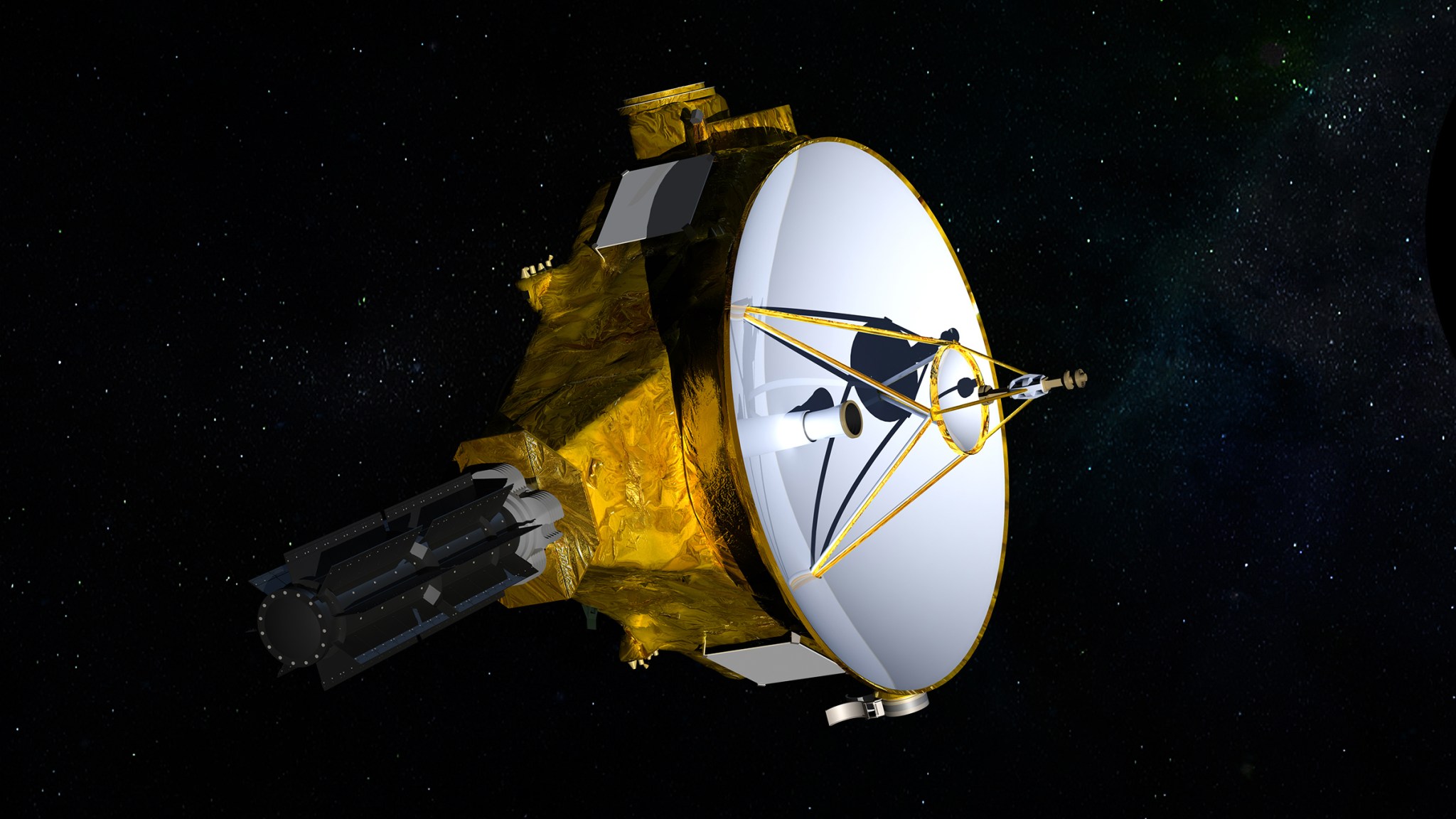
“The New Horizons mission has a unique position in our solar system to answer important questions about our heliosphere and provide extraordinary opportunities for multidisciplinary science for NASA and the scientific community,” said Nicola Fox, associate administrator for NASA’s Science Mission Directorate. “The agency decided that it was best to extend operations for New Horizons until the spacecraft exits the Kuiper Belt, which is expected in 2028 through 2029.”
This new, extended mission will be primarily funded by NASA’s Planetary Science Division and jointly managed by NASA’s Heliophysics and Planetary Science Divisions.
NASA will assess the budget impact of continuing the New Horizons mission so far beyond its original plan of exploration. As a starting point, funding within the New Frontiers program (including science research and data analysis) will be rebalanced to accommodate extended New Horizons operations, and future projects may be impacted.
Launched on Jan. 18, 2006, NASA’s New Horizons spacecraft has helped scientists understand worlds at the edge of our solar system by visiting the dwarf planet Pluto (its primary mission) and then venturing farther out for a flyby of the Kuiper belt object Arrokoth, a double-lobed relic of the formation of our solar system, and other more remote observations of similar bodies.
The Johns Hopkins University Applied Physics Laboratory in Laurel, Maryland, designed, built, and operates the New Horizons spacecraft, and manages the mission for NASA’s Science Mission Directorate. NASA’s Marshall Space Flight Center Planetary Management Office provides agency oversight for the New Horizons. Southwest Research Institute, based in San Antonio, directs the mission via Principal Investigator Stern, and leads the science team, payload operations and encounter science planning. New Horizons is part of the New Frontiers Program managed by Marshall.
What's Your Reaction?
































